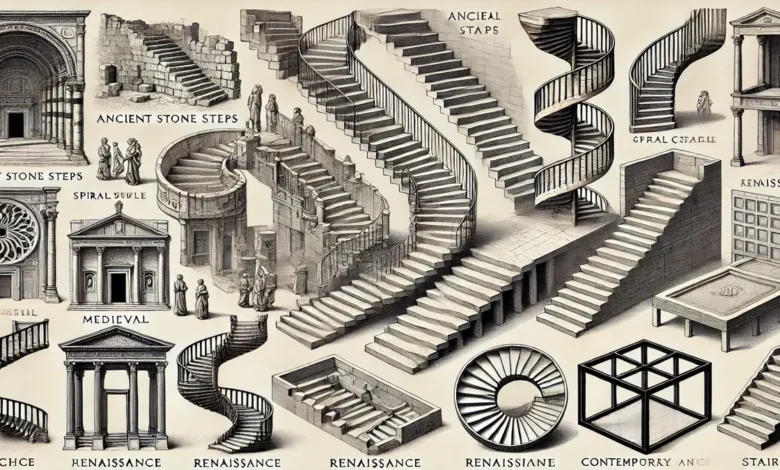What is a Flight of Stairs? Tracing the Evolution of Staircase Design Through History

Introduction
A flight of stairs, more than just a means to move between floors, has always been a significant architectural element in buildings throughout history. From ancient stone steps to the elaborate spiral staircases in medieval castles and the modern, Flight of Stairs minimalist designs seen in today’s architecture, staircases have evolved in design, materials, and construction techniques. This article delves into the historical progression of staircases, exploring how they have changed and adapted to meet the needs of different eras.
The Origins of Staircases

The Flight of Stairs earliest recorded staircases date back to over 10,000 years ago, found in archaeological sites like the ancient city of Jericho. These primitive steps were made of stone, and their primary purpose was utilitarian – to facilitate access to structures and navigate the terrain. As civilizations advanced, so did the complexity and significance of stair designs.
Ancient Civilizations and the Rise of Monumental Stairs
In Flight of Stairs ancient Egypt, flights of stairs were integral to the construction of pyramids and temples. They symbolized ascension – both physically and spiritually. The grand staircases of Mayan temples, such as those at the El Castillo pyramid in Chichen Itza, served both functional and ceremonial purposes, illustrating the staircase’s role in ritual and governance.
Flight of Stairs The classical period of Greece and Rome brought further refinements to staircase construction. The famous stairs of the Acropolis in Athens and the monumental staircases of Roman villas and palaces were not only functional but also expressions of power and prestige.
Medieval Staircases: Utility and Defense
During the medieval period, Flight of Stairs the design of staircases in castles and fortresses was heavily influenced by defence needs. Spiral staircases were common, designed to provide a tactical advantage during battles, making it difficult for attackers to ascend. These staircases were typically narrow and wound clockwise, favouring right-handed defenders.
The Renaissance to the Enlightenment: Staircases as Art
The Renaissance era brought a renewed interest in the arts and sciences, Flight of Stairs which was reflected in staircase design. The period saw the introduction of grand, sweeping staircases in palaces and public buildings, emphasizing symmetry and balance. Architects like Michelangelo and Gian Lorenzo Bernini transformed staircases into dramatic architectural features rich in decorative elements.
In the 17th and 18th centuries, the Baroque and Rococo styles favoured even more elaborate designs. The staircase became a central element in architectural planning, often designed to impress visitors. The renowned Scala Regia in the Vatican, designed by Bernini, is a prime example, with its clever use of perspective and ornamentation.
Industrial Revolution to Modernism
The Flight of Stairs advent of the Industrial Revolution in the 19th century introduced new materials such as cast iron, steel, and, later, reinforced concrete. These materials allowed for the construction of more durable and intricate staircases. The development of architectural styles like Art Nouveau and later Art Deco introduced flowing lines and geometric patterns, respectively, into staircase designs, reflecting the artistic movements of those times.
The 20th century ushered in modernism, where the focus shifted towards functionality and simplicity. Architects like Le Corbusier and Ludwig Mies van der Rohe opted for designs that emphasized clean lines and the absence of ornamentation, a trend that continues in contemporary architecture.
Contemporary Staircase Design
Today, staircases merge functionality with aesthetic appeal, incorporating materials like glass, steel, and even acrylic for minimalist and futuristic looks. Innovations in engineering and design have also led to floating staircases, where steps are attached to a wall without visible supports, creating a sleek, airy look.
Conclusion
The evolution of staircase design through history is a testament to the staircase’s role not only as a functional architectural element but also as a medium of artistic expression and technological innovation. From ancient stone steps to modern floating staircases, the design of staircases has continued to evolve, mirroring changes in architectural styles, materials, and societal needs. As architectural challenges and preferences evolve, so too will the designs of staircases, continuing to ascend to new heights of creativity and function.
This article provides a comprehensive look at the historical and cultural significance of staircases, offering insights into their development across different periods and styles.
FAQS
What defines a flight of stairs?
A flight of stairs refers to a series of steps between two floors or between two landings. The term can encompass both the steps themselves and any associated structures like bannisters or handrails that support the staircase.
Why were spiral staircases popular in medieval castles?
Spiral staircases were favoured in medieval castles primarily for defensive purposes. Their narrow, winding design made it difficult for attackers to ascend, and the clockwise construction favoured right-handed defenders, who could more easily manoeuvre their swords against those climbing up.
How did the Industrial Revolution affect staircase design?
The Industrial Revolution introduced new materials like cast iron, steel, and, later, reinforced concrete, which allowed for more durable and elaborate staircase constructions. This era marked a significant shift from traditional wooden or stone staircases to those incorporating metal and engineered materials, enabling more ambitious architectural designs.
What are the characteristics of modern staircase designs?
Modern staircase designs are characterized by their minimalist approach, emphasizing clean lines, open spaces, and the use of materials like steel, glass, and concrete. These designs often focus on simplicity and functionality, with less emphasis on ornate details compared to earlier styles.
What is a floating staircase, and how is it supported?
A floating staircase is a design where the steps are attached to a wall or a hidden stringer on one side, giving the appearance that they are hanging or floating without support. Strong, concealed attachments usually support the steps and may also be reinforced by glass or metal for additional stability and aesthetics. This design is popular in contemporary architecture for its sleek and airy appearance.





